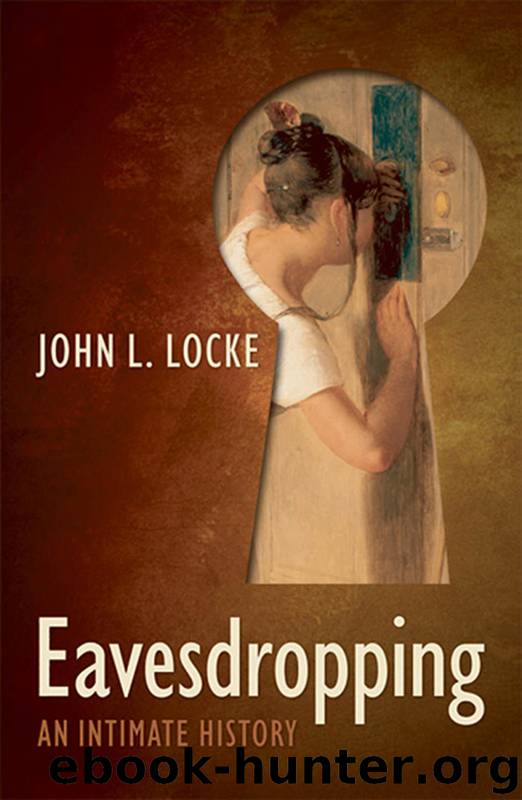Eavesdropping by Locke John L

Author:Locke, John L.
Language: eng
Format: epub
Publisher: OUP Oxford
Published: 2010-11-22T16:00:00+00:00
Gender redux
In the arrests for eavesdropping there is generally less detail than in the court-welcomed cases, as indicated, but the records reveal one thing about the people who were caught under the walls and windows of their neighbors’ houses—their gender. McIntosh has reported that for a good two hundred years, beginning in the 1370s, about eighty percent of the courts having some incidence of eavesdropping (blended with nightwalking) happened to hear male cases only.
McIntosh never actually counted the number of males and females who were arrested for eavesdropping—it was the number of courts reporting only one sex or the other, or both—but there must have been a fairly strong difference between the sexes for her to get such lopsided figures; and this presents us with a conundrum. If court-welcomed eavesdropping was so frequently carried out by women, why were so many men charged with this other kind of criminalized eavesdropping? In fact, we will see that it makes more sense to ask why so few women were arrested.
To appreciate my reasons for reframing the question, it helps to consider a fact about the architectural type of eavesdropping. It was best done under the cover of darkness. If one was detected before eavesdropping, the desired perceptual experience was unlikely to be forthcoming. If discovered afterwards, the eavesdropper might be reported. If eavesdroppers wished to avoid detection, and to escape prosecution, they needed to take up their under-eaves position at night. With poorly lighted streets, there was a chance that they might be able to do it and get away with it.
Earlier we asked who was home more often. Now it is necessary to ask: who was out at night? Out at night was not where respectable women would normally be found. Being seen out after dark posed a physical danger to women, and to their reputation, since they would have been suspected as “nightwalkers,” or prostitutes. “Merely to walk unescorted at night rendered a woman liable to be arrested for immorality,” wrote Sara Mendelson and Patricia Crawford. “Women, but not men, were subject to a de facto curfew after dark.”39
The English had a term for out-at-night individuals. They were noctivagators. The root vagor implies that nightwalkers were seen as vagrants, or wanderers, with no discernible reason for being out.40 There are indications that the “nightwalker” label was already in use in fourteenth-century London. Three centuries later, a justice ruled that it was lawful to arrest nightwalkers in order to prevent “malfeasance.”41 Since women were not supposed to venture outside at night, it was unlikely that many would be seen or arrested for eavesdropping. McIntosh reported that between 1370 and 1600 over ninety percent of the arrests for nightwalking were of men.
But were men out just because they could get away with it, or were they out for a reason that was functionally related to the eavesdropping for which they were arrested? Were they investigating? Were they patrolling what they took to be the boundaries on their own territory? Were they attempting
Download
This site does not store any files on its server. We only index and link to content provided by other sites. Please contact the content providers to delete copyright contents if any and email us, we'll remove relevant links or contents immediately.
Cecilia; Or, Memoirs of an Heiress — Volume 1 by Fanny Burney(32503)
Cecilia; Or, Memoirs of an Heiress — Volume 2 by Fanny Burney(31913)
Cecilia; Or, Memoirs of an Heiress — Volume 3 by Fanny Burney(31898)
The Lost Art of Listening by Michael P. Nichols(7456)
Asking the Right Questions: A Guide to Critical Thinking by M. Neil Browne & Stuart M. Keeley(5712)
We Need to Talk by Celeste Headlee(5575)
On Writing A Memoir of the Craft by Stephen King(4893)
Dialogue by Robert McKee(4354)
Pre-Suasion: A Revolutionary Way to Influence and Persuade by Robert Cialdini(4187)
I Have Something to Say: Mastering the Art of Public Speaking in an Age of Disconnection by John Bowe(3861)
Elements of Style 2017 by Richard De A'Morelli(3325)
The Book of Human Emotions by Tiffany Watt Smith(3271)
Fluent Forever: How to Learn Any Language Fast and Never Forget It by Gabriel Wyner(3056)
Name Book, The: Over 10,000 Names--Their Meanings, Origins, and Spiritual Significance by Astoria Dorothy(2961)
Good Humor, Bad Taste: A Sociology of the Joke by Kuipers Giselinde(2924)
Why I Write by George Orwell(2916)
The Art Of Deception by Kevin Mitnick(2770)
The Grammaring Guide to English Grammar with Exercises by Péter Simon(2725)
Ancient Worlds by Michael Scott(2653)
